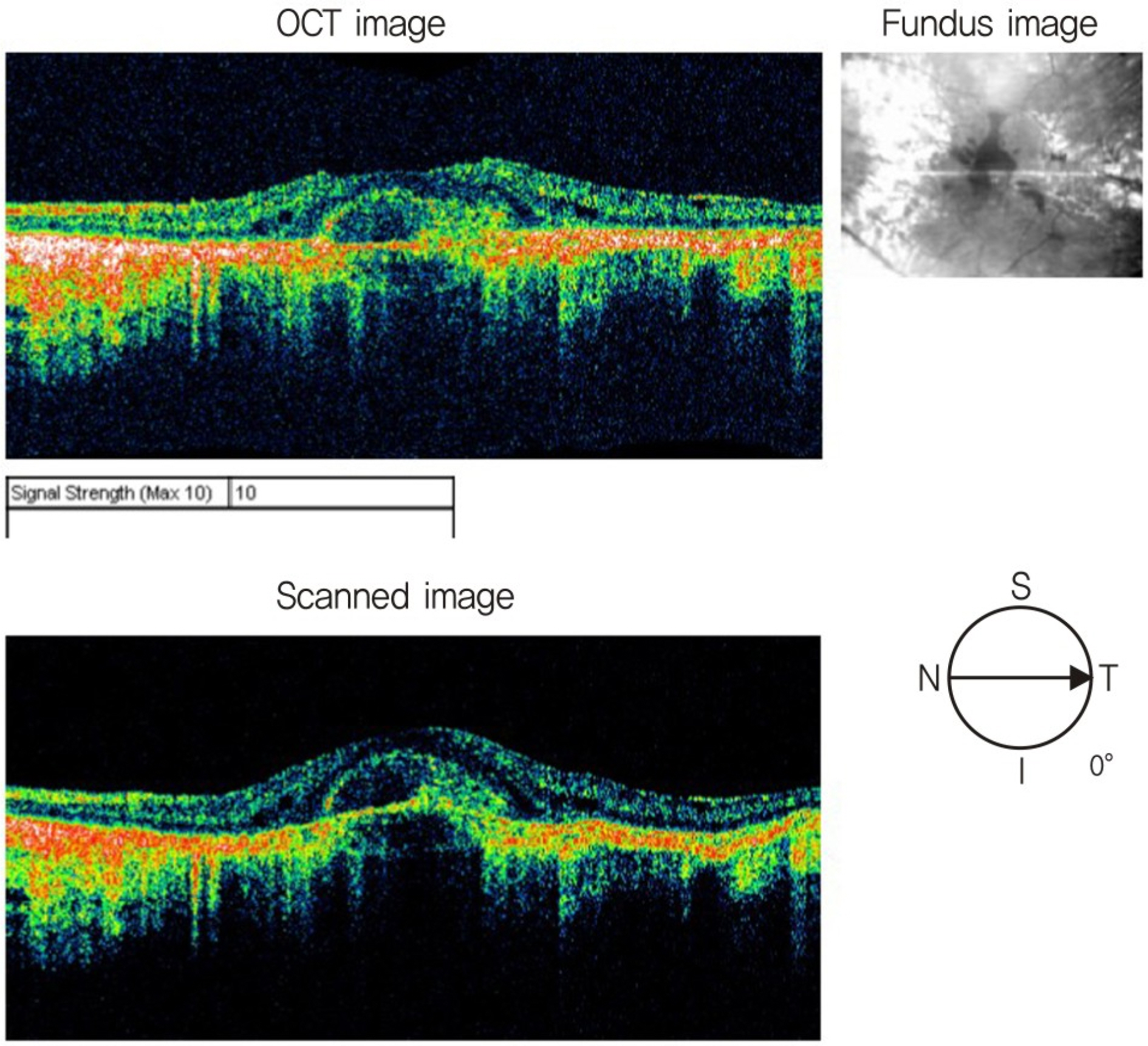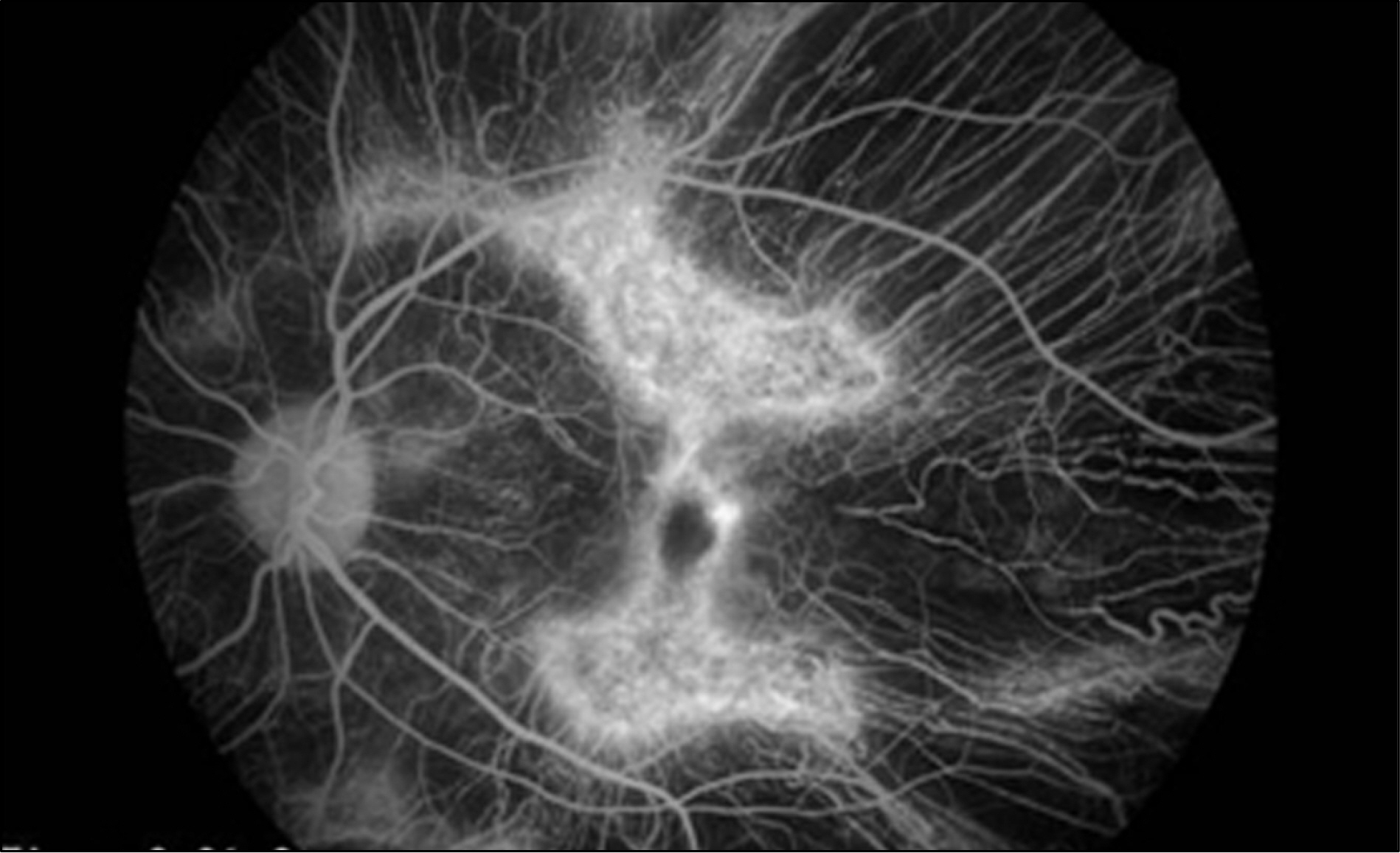J Korean Ophthalmol Soc.
2011 Jun;52(6):742-745. 10.3341/jkos.2011.52.6.742.
Regression of Choroidal Neovascularization in a Choroideremia Patient after Intravitreal Bevacizumab Injection: A Case Report
- Affiliations
-
- 1Happy Eye Clinic, Gwangju, Korea.
- 2Department of Ophthalmology, School of Medicine, Chosun University, Gwangju, Korea. eyelovehyun@hanmail.net
- 3Department of Ophthalmology, Kim's Eye Hospital, Myung-Gok Eye Research Institute, Konyang University, Daejeon, Korea.
- KMID: 2214649
- DOI: http://doi.org/10.3341/jkos.2011.52.6.742
Abstract
- PURPOSE
To report the first domestic case of choroidal neovascularization in a choroideremia patient treated with intravitreal bevacizumab injection.
CASE SUMMARY
A 29-year-old male presented with a sudden decline in vision in the left eye. Fundus examination revealed areas of choriocapillaries and retinal pigment epithelium atrophy with macular hemorrhage. Fluorescein angiogram revealed vascular hyperfluorescence in the juxtafoveal area. Neurosensory detachment around the macula and increased central macular thickness was also observed using optical coherence tomography. Upon the diagnosis of choroideremia with choroidal neovascularization, the patient was treated with 1.25 mg intravitreal bevacizumab. Visual acuity improved after four injections of intravitreal Bevacizumab with improvement in both detachment and fluorescein leakage.
CONCLUSIONS
In patients with choroideremia presenting sudden decline in vision, ophthalmologists should detect for possible choroidal neovascularization. The results from the present study show that judicious use of intravitreal Bevacizumab may be effective in such cases. Further studies with a large sample size and sufficiently long follow-up periods are required.
Keyword
MeSH Terms
Figure
Reference
-
References
1. Roberts MF, Fishman GA, Roberts DK, et al. Retrospective, longitudinal, and cross sectional study of visual acuity impairment in choroideraemia. Br J Ophthalmol. 2002; 86:658–62.
Article2. Wakabayashi K, Yoneura D, Kawasaki K, Uyama M. New approach to electrodiagnosis in diseases of the retina choroideremia. Folia Ophthalmol Japan. 1984; 35:775–9.3. Robinson D, Tiedeman J. Choroideremia associated with a subretinal neovascular membrane. Case report. Retina. 1987; 7:70–4.4. Noro Y, Yamaguchi K, Tamai M. A case of choroideremia associated with subretinal proliferation. Jap J Clin Ophthalmol. 1992; 46:962–3.5. Endo K, Yuzawa M, Ohba N. Choroideremia associated with subretinal neovascular membrane. Acta Ophthalmol Scand. 2000; 78:483–6.
Article6. Sawa M, Tamaki Y, Klancnik JM Jr, Yannuzzi LA. Intraretinal foveal neovascularization in choroideremia. Retina. 2006; 26:585–8.
Article7. Mauthner H. Ein fall von choroideremia. Ber Nat Med Ver Innsbruck. 1872; 2:191.8. Krill AE, Archer D. Classification of the choroidal atrophies. Am J Ophthalmol. 1971; 72:562–85.
Article
- Full Text Links
- Actions
-
Cited
- CITED
-
- Close
- Share
- Similar articles
-
- Effect of High-dose Intravitreal Bevacizumab Injection on Refractory Idiopathic Choroidal Neovasculariz
- A Case of Intravitreal Bevacizumab Injection for the Treatment of Choroidal Neovascularization in Morning Glory Syndrome
- Choroidal Neovascularization in a Patient with Best Disease
- Intravitreal Bevacizumab Injection for the Treatment of Choroidal Neovascularization Secondary to Candida Chorioretinitis
- Long-term Therapeutic Effect of Intravitreal Bevacizumab (Avastin) on Myopic Choroidal Neovascularization





